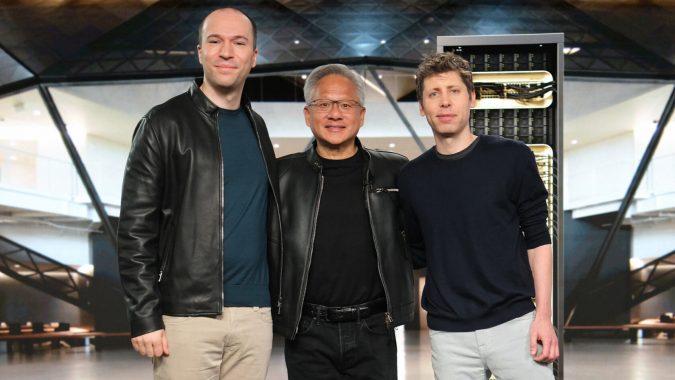
The race to build massive GPU farms, or AI factories, is in full swing, and by all accounts, Nvidia is sitting in the pole position. Flush with cash from surging GPU sales, the Santa Clara, California GPU company is looking for investments that can generate returns and keep the virtuous cycle moving. What better place to invest, then, than in your own hyperscale customers?
That appears to be the logic behind today’s news of a landmark alliance between Nvidia and OpenAI, which could see the GPU giant investing up to $100 billion into the AI firm as part of a plan to build 10 gigawatts of AI data center infrastructure.
Nvidia’s investment in OpenAI is tied to the opening of new data centers, which is measured in power capacity. The first phase of what could become 10 gigawatts of data center capacity is targeted to come online in the second half of 2026, and utilize Nvidia’s new Vera Rubin GPU-CPU superchips.
The investment in OpenAI comes less than a week after Nvidia announced it was taking a $5 billion stake in Intel as part of a plan that will see Intel adopting Nvidia’s NVLink technology for future data center superchips that combine GPUs and CPUs on the same die. The two companies also announced they would collaborate on using NVLink for a new generation of consumer-grade chips that fuse Nvidia GPU RTX chips onto Intel boards.

Nvidia CEO Jensen Huang delivering the first DGX system to OpenAI in 2016
In an interview on CNBC, Nvidia Founder and CEO Jensen Huang discussed his vision for the future of AI.
“It is very soon where every single word, every single interaction, every single image and video that we experience through computers will somehow have been reasoned through or referenced by or generated by AI,” Huang told CNBC. “It’s going to be touched by AI somehow. So all of our computing experiences throughout the day, everywhere, in every industry, will be powered by AI.”
There’s never been an engineering project as large or complex as the 10 gigawatts in data center capacity that Nvidia and OpenAI will collaborate to build, Huang said.
“This is the first 10 gigawatts, surely it sounds like an enormous undertaking. But there’s no question that AI is transformational for every industry,” he said. “But the important thing is the AI infrastructure will be everywhere and it will power computing experiences for everyone everyday. And it’s going to be just everywhere.”
OpenAI unveiled GPT-5 about a month ago, marking the company’s first major new LLM since it released GPT-4 in the spring of 2023. However, the new model, which features a built-in controller that will automatically route user requests to standard GPT or to reasoning sub-models, has faced a lackluster reception.
With 700 million weekly customers, OpenAI is looking for ways to monetize its reach and AI investments. The company raised another $8.3 billion last month, which adds to the $40 billion it raised earlier this year in a venture capital round that valued it at $300 billion.
OpenAI, which has used Nvidia GPUs and was the first customer for Nvidia’s new DGX system back in 2016, has not publicly disclosed what comes after GPT-5. In the announcement, the two companies say OpenAI is on the path to delivering “superintelligence.” More information about the partnership will be released in the coming weeks, the companies said.
Nvidia’s stock rose about 3.5% immediately following the announcement. The market capitalization for the most valuable company in the world increased about $150 billion to nearly $4.5 trillion.
This article first appeared on our sister publication, HPCwire.

